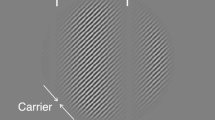Summary
The stimulus response characteristics (SRCs) of 33 phasic retinal ganglion cells were established on the basis of extracellular recordings in the optic tract of anaesthetized and paralyzed cats. All SRCs were best described with two straight lines in double logarithmic coordinates. The near threshold light intensity summation was found to be linear, on the average up to 4.8 times threshold. The cells' threshold, defined as smallest response outside the 95%-confidence interval of the spontaneous activity (SpA) distribution, is dependent on the slope of the gain near threshold (linear gain) and the standard deviation of the spontaneous activity (SpA-scatter) prior to stimulation. The slope of the double logarithmic relationship at higher intensities (non-linear gain) — corresponding to the exponent of the power function — increases with threshold intensity. The linear, near threshold gain was used to describe the retinotopic distribution of the cells' threshold-and suprathreshold sensitivity. This sensitivity is high in the center of the retina decreasing steadily towards the periphery. Threshold, as well as linear and non-linear gain are interdependent parts of the SRC, specific for each ganglion cell and, furthermore, the geometrical mean between threshold activity and the response activity at the intersection point of the two regression lines is constant around 30 imp/s, irrespective of the cell's range of operation. The entire course of the SRC can therefore be predicted on the basis of the SpA-scatter and threshold intensity. The homogeneous population of investigated Y-ganglion cells proved to be a set of cells with summation characteristics, changing systematically with threshold and the distance of the receptive field from area centralis.
Similar content being viewed by others
References
Barlow HB, Levick WR (1969a) Coding of light intensity by the cat retina. In: Reichardt W (ed) Processing of optical data by organisms and machines. Proceedings of the International School of Physics ‘Enrico Fermi’, Vol 43, Academic Press, New York, pp 384–396
Barlow HB, Levick WR (1969b) Three factors limiting the reliable detection of light by retinal ganglion cells of the cat. J Physiol (Lond) 200: 1–24
Bishop PO, Burke W, Davis R (1962) The identification of single units in the central visual pathways. J Physiol (Lond) 162: 409–431
Bishop PO, Kozak W, Vakkur GJ (1962) Some quantitative aspects of the cat's eye: axis and plane of reference, visual field co-ordinates and optics. J Physiol (Lond) 163: 466–502
Cleland BG, Levick WR, Sanderson KJ (1973) Properties of sustained and transient ganglion cells in the cat retina. J Physiol (Lond) 228: 649–680
Creutzfeldt O, Sakmann B, Scheich H (1968) Zusammenhang zwischen Struktur und Funktion der Retina. Kybernetik 4: 239–262
Drum B (1976) The relationship of apparent brightness to contrast threshold on photopic background: dependence on retinal position and target size. Vision Res 16: 1401–1406
Enroth-Cugell C, Lennie P, Shapley RM (1975) Surround contribution to light adaptation in cat retinal ganglion cells. J Physiol (Lond) 247: 579–588
Enroth-Cugell C, Shapley RM (1973a) Adaptation and dynamics of cat retinal ganglion cells. J Physiol (Lond) 233: 271–309
Enroth-Cugell C, Shapley RM (1973b) Flux, not retinal illumination, is what the cat retinal ganglion cells really care about. J Physiol (Lond) 233: 311–326
Fischer B, May HU (1970) Invarianzen in der Katzenretina: Gesetzmäßige Beziehungen zwischen Empfindlichkeit, Größe und Lage rezeptiver Felder von Ganglienzellen. Exp Brain Res 11: 448–464
Hammond P (1974) Cat retinal ganglion cells: size and shape of receptive field centers. J Physiol (Lond) 242: 99–118
Hughes A (1981) Population magnitudes and distribution of the major modal classes of cat retinal ganglion cells as estimated from HRP filling and a systematic survey of the soma diameter spectra for classical neurones. J Comp Neurol 197: 303–339
Krantz DH (1972) Visual Scaling. In: Jameson D, Hurvich LM (eds) Handbook of sensorial physiology, Vol VII/4 Visual psychophysics. Springer, Berlin Heidelberg New York, pp 660–689
Peichl L, Wässle H (1979) Size, scatter and coverage of ganglion cell receptive field centres in the cat retina. J Physiol (Lond) 291: 117–141
Pöppel E, Harvey LO Jr (1973) Light-difference threshold and subjective brightness in the periphery of the visual field. Psychol Forsch 36: 145–161
Roenneberg T (1983) Topographie der Lichtsummation phasischer Ganglienzellen auf der Katzenretina. Dissertation der Fakultät für Biologie der LMU-München
Snider RS, Niemer WT (1970) A stereotaxic atlas of the cat brain (3rd ed). University Chicago Press, Chicago
Steinberg R, Reid M, Lacy L (1973) Distribution of rods and cones in the retina of the cat. J Comp Neurol 148: 229–248
Stevens SS (1971) Sensory power functions and neural events. In: Loewenstein WR (ed) Handbook of sensorial physiology, Vol I. Principles of receptor physiology. Springer, Berlin Heidelberg New York, pp 226–242
Stone J (1978) The number and distribution of ganglion cells in the cat's retina. J Comp Neurol 180: 753–772
Stone J, Fabian M (1968) Summing properties of the cat's retinal ganglion cell. Vision Res 8: 1023–1040
Wässle H, Levick WR, Cleland BG (1975) The distribution of the alpha-type of ganglion cells in the cat's retina. J Comp Neurol 159: 419–437
Werblin FS, Dowling JE (1969) Organisation of the retina of the mudpuppy, Necturus maculosus: Intracellular recordings. J Neurophysiol 32: 339–355
Zihl J, Lissy P, Pöppel E (1980) Brightness perception in the visual field: effects of retinal position and adaption level. Psychol Res 41: 297–304
Author information
Authors and Affiliations
Additional information
Our work was supported by the Deutsche Forschungsgemeinschaft (SFB 50-C6)
Rights and permissions
About this article
Cite this article
Roenneberg, T., Pöppel, E. Topographical distribution of the summation property of Y-ganglion cells in the cat retina. Exp Brain Res 59, 1–9 (1985). https://doi.org/10.1007/BF00237659
Received:
Accepted:
Issue Date:
DOI: https://doi.org/10.1007/BF00237659




